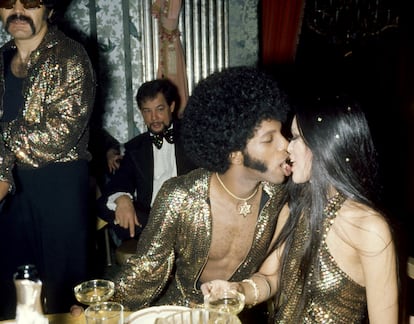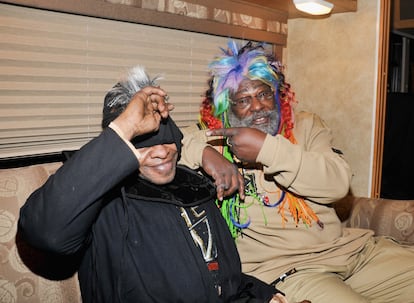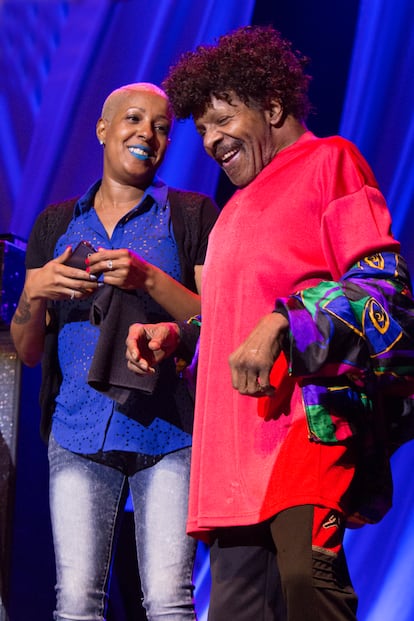Sly Stone, the artist who changed music history and disappeared: ‘He had everything and almost deliberately threw it away’
The documentary ‘Sly Lives! (aka The Burden of Black Genius)’ explores the meteoric rise and dramatic fall of Sly & The Family Stone — a band that defined a new era in the 1960s, led by a frontman as brilliant as he was erratic


After Elvis Presley, Bob Dylan, John Lennon, and Paul McCartney, a late-1960s American magazine boldly predicted that Sly Stone (born Sylvester Stewart) would be the generation’s “new leader.” With a smaller catalog and a shorter reign at the top than those iconic figures, the claim may now seem inflated — but at the time, it reflected a real sense of promise. As the frontman of Sly & The Family Stone, the African American musician was becoming a chronicler of a paradigm shift and the voice of a new horizon shaped by the hippie dream, protests against the Vietnam War, and the civil rights movement. Two historic performances sealed his status in 1969: first at the Harlem Cultural Festival, then at Woodstock.
But as that promised new world failed to materialize, Sly Stone’s brilliance faded prematurely — lost amid addiction, media pressure, and disastrous shows, not to mention sudden cancellations that sometimes sparked riots. In 1975, only a few hundred people showed up to see Sly & The Family Stone perform in a New York venue that could hold over 6,000, a clear sign of the fatigue and distrust his name had come to evoke. As was his habit, the singer arrived an hour late and played for just 45 minutes. Beyond the financial debacle, the flop effectively led to the group’s dissolution — though Sly would continue releasing records and performing under his own name until the 1980s.
The documentary Sly Lives! (aka the Burden of Black Genius) frames his fall from grace within the broader disillusionment that marked the end of a decade filled with high hopes, while also highlighting the enduring magnitude of an artistic legacy that not even its own creator could destroy.

“There was Black music before Sly Stone and there was Black music after Sly Stone. Simple as that,” wrote U.S. critic Joel Selvin in his book Sly & The Family Stone: An Oral History (1998). Selvin is one of the people interviewed in the recently released documentary and, when asked by EL PAÍS, he confesses that he is unable to pinpoint a single “definitive or decisive transformation” brought about by Stone. “The whole model was unknown, whether it was the band’s composition, the mix of rock, folk, and R&B elements, or the subject matter of the songs,” he replies.
A childhood prodigy, a multi-instrumentalist and highly influential DJ, as well as a producer, session musician and live performer for numerous bands, Sly officially formed the group at the age of 23, alongside two of his brothers and five other artists. The title of their first album, A Whole New Thing (1967), openly declared their ambition, although it was their follow-up, Dance To The Music (1968), that propelled them to commercial success and set off a psychedelic, progressive ripple across contemporary funk.
In late 1968 — the year Martin Luther King was assassinated — Sly released an anthem for a new era: the stirring Everyday People, a call for equality that, with the cry of “We’ve got to live together!”, urged unity among Black and white hippies, men and women. The band itself embodied that utopian vision of peaceful coexistence from the start: three Black men, two Black women, and two white men. That inclusive makeup helped different audiences see themselves in the group, which also helped their commercial appeal.
Sly Lives! (aka the Burden of Black Genius) reminds us that, in that decade, the scars of segregation were still vivid — one band member recalls an incident where a police officer hurled a racial slur at Sly’s then-girlfriend, a white woman. The everyday violence of the time was so raw that groups like the Black Panther Party considered the band’s stance naïve and even demanded the removal of its white members.

“The makeup of the band was a statement in itself,” says Selvin. For the book he published in the late 1990s, the writer gathered testimonies from much of the Sly & The Family Stone inner circle and every musician who was ever part of the group — except Sly Stone himself, who also did not participate in the recent documentary, this time due to health reasons.
Stone has been in a decline that never quite seemed to hit bottom. Retired since the 1980s — though he played a few concerts with his friend George Clinton (from the band Parliament-Funkadelic) — his public image soon became reduced to exploitative TV appearances as a sideshow act, and near-daily headlines about cocaine possession arrests. In the 2000s, he agreed to join a reunion tour with his former bandmates, but would only appear for two or three songs each night, frustrating fans who had been promised a full-scale reunion.
Gradually, sightings of Stone became rarer and his behavior more reclusive, until the U.S. press dubbed him “the J.D. Salinger of funk.” For Selvin, part of that retreat is because “he undoubtedly feels a deep melancholy, likely some guilt and a lot of remorse” over his wasted talent and potential. “All his friends from back then look at him with pity, like someone who had everything and almost deliberately threw it away,” he tells EL PAÍS.
The burden of talent
Unlike classic music documentaries that follow a familiar arc of rise, fall, and triumphant comeback or tragic demise, Sly Lives! (aka the Burden of Black Genius) rejects this typical narrative and denies the viewer a conventional third act. Sly Stone may never have staged a dramatic return, but — as the triumphant, celebratory “Sly Lives!” in the title reminds us — he also escaped the cruel, sacrificial logic of show business.
“He’s kind of just like a standard old Black man,” says his daughter Novena Carmel, a DJ and radio host, in the film. “For his birthday, I asked him what he wanted to eat, and he requested a big pizza, with all of the toppings. He’s also a big fan of westerns and cars.”
In 2011, reports emerged that he was homeless, supported by an elderly couple who made sure he ate daily. However, friends and close collaborators later denied these claims, explaining that he often chose to live in a camper van, depending on the season. Today, the 82-year-old is sober and living in a house in Southern California, surrounded by his children and grandchildren.

Sly Lives! is directed by musician, journalist, and filmmaker Ahmir Khalid Thompson — better known as Questlove — who won the Oscar for Best Documentary with Summer of Soul (2021), a film that also featured Sly & The Family Stone as it centered on the 1969 Harlem Cultural Festival. In that project, Questlove reflected on the media erasure of culturally significant events for Black communities (the Harlem concerts drew crowds comparable to Woodstock but received almost no coverage). In this new documentary, he begins by asking what we mean when we talk about “Black genius” — that idealized, exemplary figure onto whom the weight of embodying a community’s highest values is placed.
Rather than delivering a moralizing tale of addiction and punishment, Sly Lives! addresses the scrutiny and relentless expectations placed on successful Black artists — held to a different standard than their white peers, with far fewer chances for redemption. In a montage of Black celebrities whose careers were derailed by pressure and self-sabotage, we see Will Smith accepting his controversial 2022 Oscar — a pointed inclusion, as Questlove’s own win that night was overshadowed by Smith’s infamous slap of Chris Rock. The reference to Smith can be read as a quiet gesture of forgiveness from the director.

The surviving members of Sly & The Family Stone speak warmly in the documentary about their former frontman, despite the fact that, in the 1970s, he alienated many of them with the entourage he surrounded himself with — including mafia bodyguards — and abandoned them onstage, sometimes telling the crowd he was going to the bathroom, to never return. Larry Graham, one of the most influential bassists of all time, left the band convinced that Stone had ordered a hit on him over internal disputes.
Then there were the cocaine-fueled antics: in a move reminiscent of Kanye West, Sly turned a 1974 concert at Madison Square Garden into his wedding, complete with dancers, laser lights, and a plan to release thousands of doves — an idea that was scrapped after the venue refused due to his unwillingness to pay for extra security. The marriage, to model Kathy Silva, lasted just two years. Their son, Sylvester Jr., was later attacked by Sly’s dog due to the singer’s negligence. In addition to Novena and Sylvester Jr., Sly has a third daughter, Phunne, whose mother was the group’s trumpet player and singer, Cynthia Robinson.
Photographer and designer Stephen Paley — who created the iconic cover of There’s A Riot Goin’ On (1971), featuring a red, white, and black American flag — says that Sly became “sullen” after feeling that he had created a whole new musical and cultural language, only to watch others use it to build their own success. “He invented an alphabet,” Paley says, “and then other people started writing books with it.”
Prince famously modeled his era with The Revolution after Sly & The Family Stone’s image, often paying tribute by covering Stand! live. In the 1990s, the same generation that had grown up hearing about Sly’s arrests and meltdowns on TV helped bring his music back into the spotlight, as his work was heavily sampled by LL Cool J, Beastie Boys, Public Enemy, and Janet Jackson.

“I never lived a life I didn’t want to live,” Stone told journalist Alexis Petridis in 2023, during an interview with The Guardian marking the release of his autobiography Thank You (Falettinme Be Mice Elf Agin) — named after the band’s hit song.
In both the interview and the book, Stone resists the cliché of the tormented, doomed artist when reflecting on his own life. Petridis, one of the few journalists to speak with Stone during his more reclusive years, recalls a much more chaotic phone interview back in 2013 — when Stone was still using drugs — in which the musician claimed he wanted to form a new band made up entirely of musicians with albinism to “neutralize all the different racial problems,” arguing that “all races have albinos.”
Now at 82 and living with a debilitating lung condition, the albino band will have to go ahead without him. But his ideas — and the musical “alphabet” he created — remain available to the generations he continues to inspire.
Sign up for our weekly newsletter to get more English-language news coverage from EL PAÍS USA Edition
Tu suscripción se está usando en otro dispositivo
¿Quieres añadir otro usuario a tu suscripción?
Si continúas leyendo en este dispositivo, no se podrá leer en el otro.
FlechaTu suscripción se está usando en otro dispositivo y solo puedes acceder a EL PAÍS desde un dispositivo a la vez.
Si quieres compartir tu cuenta, cambia tu suscripción a la modalidad Premium, así podrás añadir otro usuario. Cada uno accederá con su propia cuenta de email, lo que os permitirá personalizar vuestra experiencia en EL PAÍS.
¿Tienes una suscripción de empresa? Accede aquí para contratar más cuentas.
En el caso de no saber quién está usando tu cuenta, te recomendamos cambiar tu contraseña aquí.
Si decides continuar compartiendo tu cuenta, este mensaje se mostrará en tu dispositivo y en el de la otra persona que está usando tu cuenta de forma indefinida, afectando a tu experiencia de lectura. Puedes consultar aquí los términos y condiciones de la suscripción digital.
More information
Archived In
Últimas noticias
ChatGPT fails the test: This is how it endangers the lives of minors
The late consecration of women artists in their 90s
The Florida Keys tourist paradise is besieged by immigration agents: ‘We’ve never seen anything like this’
The latest scam on WhatsApp behind the legal dream: using immigration status as bait
Most viewed
- Families demand repatriation of bodies of Colombians who died in Ukraine: ‘This war is a slaughterhouse for foreigners’
- The low-cost creative revolution: How technology is making art accessible to everyone
- Liset Menéndez de la Prida, neuroscientist: ‘It’s not normal to constantly seek pleasure; it’s important to be bored, to be calm’
- Christian Louboutin: ‘Young people don’t want to be like their parents. And if their parents wear sneakers, they’re going to look for something else’
- ‘El Limones’ and the growing union disguise of Mexican organized crime









































